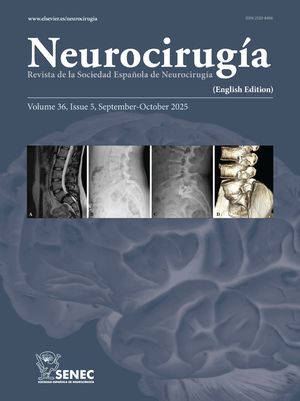La centralización de los servicios de Neurocirugía condiciona que los pacientes que sufren un traumatismo craneal, y que son atendidos de forma inicial por centros comarcales, deban ser remitidos al hospital neuroquirurgico para su valoración. Esto supone el desplazamiento de un número elevado de pacientes que, una vez valorados, regresan al centro emisor. La incorporación de la telerradiologia puede limitar el traslado a aquellos casos que requieren una asistencia más especializada.
Objetivos: 1) presentar la experiencia inicial y los resultados de un estudio piloto de interconexión telerradiológica entre un hospital comarcal y un hospital de tercer nivel para la valoración neuroquirúrgica de pacientes con un traumatismo craneoencefálico (TCE), 2) describir la infraestructura y el soporte tecnológico necesario para este tipo de proyectos, 3) analizar las repercusiones del establecimiento de una conexión telerradiológica en los centros implicados (emisor y receptor), 4) evaluar la efectividad del sistema para evitar traslados innecesarios y 5) evaluar la efectividad en mejorar la rapidez y calidad en el traslado de los pacientes neurotraumáticos.
Material y MétodosEn enero de 1998, la Unidad de Neurotraumatología del Hospital Universitario Valí d’Hebron establece una conexión telerradiológica con el Hospital General de Vic para la valoración neuroquirúrgica de pacientes con un TCE. La información clínica de cada paciente se recibe por fax convencional. Las imágenes de la TC cerebral, que han sido digitalizadas, comprimidas y preparadas para su transmisión con el programa StatView™, se trasmiten vía módem a nuestro centro. La visualización de estas imágenes se realiza en la pantalla de un PC convencional dotado del software MultiView™. Después de valorada la exploración neurorradiológica, el neurocirujano de guardia emite el informe pertinente al hospital emisor con las indicaciones a seguir respecto al traslado del paciente o su tratamiento (ingreso, observación etc.).
ResultadosAnalizamos los resultados de nuestra experiencia después de 5 años del inicio de este tipo de conexión telerradiológica.
ConclusionesLa utilización de la telerradiologia en el manejo diario de los pacientes con un TCE aporta un claro beneficio asistencial y supone una mayor racionalización de los recursos, redundando en un importante ahorro económico para el sistema sanitario. La efectividad del sistema en reducir los tiempos accidente-tratamiento en los casos graves, depende más de la infraestructura sanitaria de cada área geográfica que de sistemas sofisticados de telemedicina. La imple-mentación de estos métodos debe ir acompañada de otras medidas de ámbito político/sanitario dirigidas a conseguir un traslado más rápido de los pacientes seleccionados.
Because of the centralization of neurosurgical ser-vices, many head-injured patients who are initially evaluated in district general hospitals need to be trans-ferred to a high technology centre for neurosurgical assessment. However, after assessment, many of these patients are sent back to the original hospital. Establis-hing a teleradiological system between the two hospitals would elimínate these unnecessary transfers.
Objectives1) to describe our initial experience and the results of a pilot study of the teleradiological link between a district general hospital and a tertiary hospital for neurosurgical assessment of head-injured patients, 2) to describe the infrastructure and the tech-nological support required for this project, 3) to analyse the effects of the teleradiological link in both centers (referring and receiving), 4) to evalúate the effective-ness of the system in avoiding unnecessary transfers, and 5) to assess its effectiveness in improving the speed and the quality of transfers in head-injured patients.
Material and methodsIn January 1998, the Neuro-traumatology Unit of Valí d’Hebron University Hospital established a teleradiological link with the General Hospital of Vic for the neurosurgical evaluation of head-injured patients. The General Hospital of Vic sent the patients’ clinical information by fax. CT sean images were digitalized, compressed and prepared for trans-mission with the StatView™ program, and were then transmitted by modem to the receiving center. The duty neurosurgeon viewed the images on a PC screen using MutiView™ software. After evaluating this clinical and radiological information the neurosurgeon sent a report back to the referring center recommending transfer or management (admission, observation, etc.).
ResultsWe analyse the results of our experience 5 years after the implantation of the teleradiological link.
ConclusionsThe use of teleradiology in the daily management of head-injured patients provides clear beneflts and leads to a more rational use of resources, thus signiflcantly reduces costs. The effectiveness of the system in reducing the interval between the injury and treatment in severe cases depends more on the infrastructure of the health system in each geogra-phical área than on sophisticated telemedicine sys-tems. These methods should be accompanied by other measures designed to hasten the transfer of selected patients.
Article

If it is the first time you have accessed you can obtain your credentials by contacting Elsevier Spain in suscripciones@elsevier.com or by calling our Customer Service at902 88 87 40 if you are calling from Spain or at +34 932 418 800 (from 9 to 18h., GMT + 1) if you are calling outside of Spain.
If you already have your login data, please click here .
If you have forgotten your password you can you can recover it by clicking here and selecting the option ¿I have forgotten my password¿.






